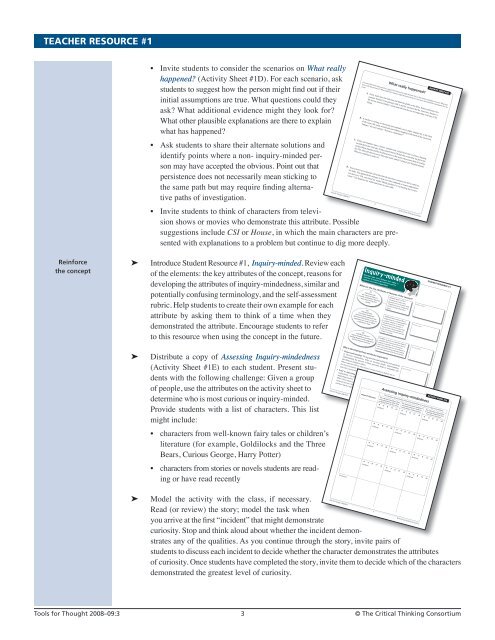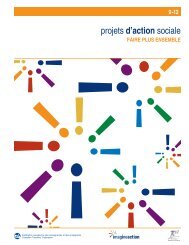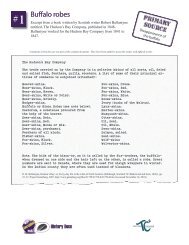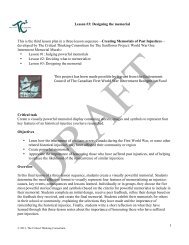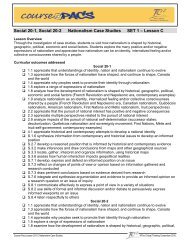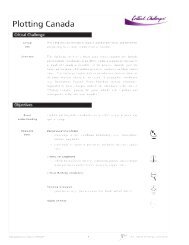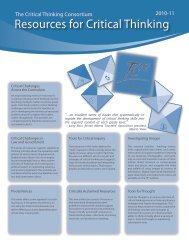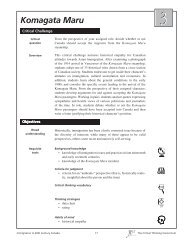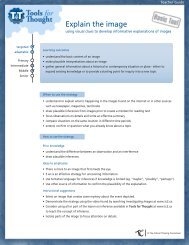Inquiry-mindedness - The Critical Thinking Consortium
Inquiry-mindedness - The Critical Thinking Consortium
Inquiry-mindedness - The Critical Thinking Consortium
You also want an ePaper? Increase the reach of your titles
YUMPU automatically turns print PDFs into web optimized ePapers that Google loves.
TEACHER RESOURCE #1• Invite students to consider the scenarios on What reallyhappened? (Activity Sheet #1D). For each scenario, askstudents to suggest how the person might find out if theirinitial assumptions are true. What questions could theyask? What additional evidence might they look for?What other plausible explanations are there to explainwhat has happened?• Ask students to share their alternate solutions andidentify points where a non- inquiry-minded personmay have accepted the obvious. Point out thatpersistence does not necessarily mean sticking tothe same path but may require finding alternativepaths of investigation.• Invite students to think of characters from televisionshows or movies who demonstrate this attribute. Possiblesuggestions include CSI or House, in which the main characters are presentedwith explanations to a problem but continue to dig more deeply.What really happened? Tools for Thought 2008-09:3 8 © <strong>The</strong> <strong>Critical</strong> <strong>Thinking</strong> <strong>Consortium</strong>ACTIVITY SHEET #1DReinforcethe concept➤➤Introduce Student Resource #1, <strong>Inquiry</strong>-minded. Review eachof the elements: the key attributes of the concept, reasons fordeveloping the attributes of inquiry-<strong>mindedness</strong>, similar andpotentially confusing terminology, and the self-assessmentrubric. Help students to create their own example for eachattribute by asking them to think of a time when theydemonstrated the attribute. Encourage students to referto this resource when using the concept in the future.#3)Individuals who areinquiry-minded are persistent inlooking deeply to seek imaginativeand non-obvious solutions.<strong>Inquiry</strong>-mindeddoes not take everything at face value; isinclined to inquire into matters and toexplore unanswered questionsWhat are the key attributes or features of the concept?#1)Individuals whoare inquiry-minded aresincerely interested in learningmore about things andpeople.#2)Individuals whoare inquiry-minded areinclined to pose questions thatseek more information or look forexplanations in order to betterunderstand a topic.EXAMPLE: When I am firstintroduced to a topic, manyquestions occur to me about whatis happening, why it is happening,and how it might affect me orothers.EXAMPLE: When someone offers asimple answer to a complex problem,I question whether it is rea ly thatstraightforward. For example, ifsomeone claims tha the reason thatpoverty exists is because people arelazy, I am hesitan to believe tha theanswer i so simple.EXAMPLE: A doctor or a detective might beunsatisfied with what seems like an obviousMy own example:My own example:STUDENT RESOURCE #1solution to a problem. He or she noticesdetails that might lead to a more effective or➤➤Distribute a copy of Assessing <strong>Inquiry</strong>-<strong>mindedness</strong>(Activity Sheet #1E) to each student. Present studentswith the following challenge: Given a groupof people, use the attributes on the activity sheet todetermine who is most curious or inquiry-minded.Provide students with a list of characters. This listmight include:• characters from well-known fairy tales or children’sliterature (for example, Goldilocks and the ThreeBears, Curious George, Harry Potter)• characters from stories or novels students are readingor have read recentlyWhy is developing these attributes important?more accurate conclusion and keeps lookingeven when faced with difficulties or barriers.• Deeper understanding: Posing questions and looking beyond superficialor obvious explanations helps us develop deeper understanding.Understanding the answers to these questions helps us remember andalso helps us explain to others.When someone tells me that using a certain product is bad for me orfor the environment, I want to know more about why it is badt for meand what a good alternative is.• Lead to interesting results: By raising questions and looking forexplanations, we often find out about things that are surprising andinteresting to know.When I hear about a famous person and take the time to learn moreabout the person’s life I am often surprised about the interesting eventsand how much I might have in common with the person.My own example:My own example:My own example:Tools for Thought 2008-09:3 10 © <strong>The</strong> <strong>Critical</strong> <strong>Thinking</strong> <strong>Consortium</strong>Conclusion:Assessing inquiry-<strong>mindedness</strong>This character demonstrates the following attributes of curiosity or inquiry-<strong>mindedness</strong>.<strong>The</strong> individual questions facts <strong>The</strong> individual poses questions <strong>The</strong> individual is persistentName of Character and explanations rather than and seeks reasons in order to in seeking imaginative andaccepting them at face value. build deeper understanding. non-obvious solutions.ACTIVITY SHEET #1E-2 -1 0 +1 +2 -2 -1 0 +1 +2 -2 -1 0 +1 +2Evidence: Evidence: Evidence:-2 -1 0 +1 +2 -2 -1 0 +1 +2 -2 -1 0 +1 +2Evidence: Evidence: Evidence:-2 -1 0 +1 +2 -2 -1 0 +1 +2 -2 -1 0 +1 +2Evidence: Evidence: Evidence:-2 -1 0 +1 +2 -2 -1 0 +1 +2 -2 -1 0 +1 +2Evidence: Evidence: Evidence:➤➤Model the activity with the class, if necessary.Read (or review) the story; model the task whenyou arrive at the first “incident” that might demonstratecuriosity. Stop and think aloud about whether the incident demonstratesany of the qualities. As you continue through the story, invite pairs ofstudents to discuss each incident to decide whether the character demonstrates the attributesof curiosity. Once students have completed the story, invite them to decide which of the charactersdemonstrated the greatest level of curiosity.Tools for Thought 2008-09:3 9 © <strong>The</strong> <strong>Critical</strong> <strong>Thinking</strong> <strong>Consortium</strong>Tools for Thought 2008–09:3 3 © <strong>The</strong> <strong>Critical</strong> <strong>Thinking</strong> <strong>Consortium</strong>


